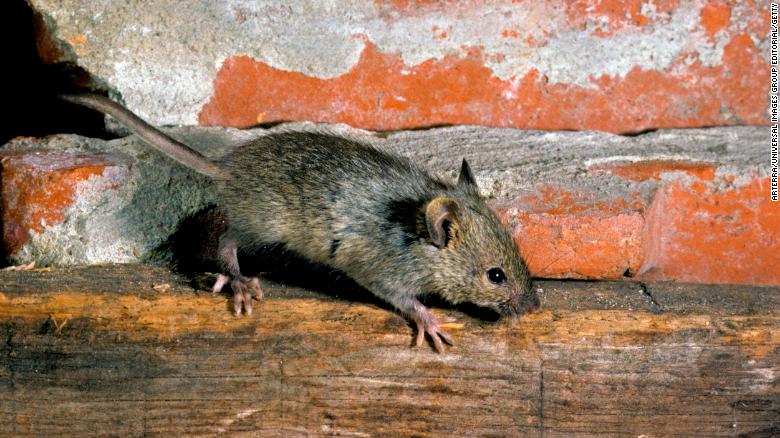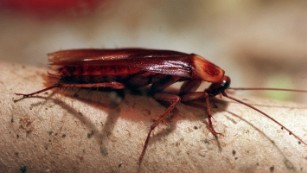New viruses, superbugs found in study of New York house mice
By Susan Scutti, CNN
Updated 1:50 PM ET, Tue April 17, 2018

House mouse (Mus domesticus / Mus musculus) foraging inside building. (Photo by: Arterra/UIG via Getty Images)
Story highlights
- Mice captured across NYC carried 36 separate viruses, including six new ones
- They also carried bacteria including E. coli, Shigella and Salmonella
(CNN)House mice don't carry door keys, but they can freely enter any residence in New York City, from low-rent studios to penthouse suites.
A yearlong assessment of the city's residential mouse population found that what many of these rodents do carry are previously unseen viruses as well as bacteria capable of causing life-threatening human illness. Some of the bacteria were even antibiotic-resistant.
"Mouse droppings may contain harmful bacteria that are difficult to treat with common antibiotics," said Dr. W. Ian Lipkin, senior author of the two papers resulting from the study and a professor of epidemiology at Columbia University's Mailman School of Public Health. "Contaminated areas should be thoroughly cleaned, and contaminated food should be discarded."
Lipkin's research was published Tuesday in mBio, the journal of the American Society for Microbiology.
'More worrisome' than rats
Over a period of about a year, Lipkin and his colleagues collected 416 mice from residential buildings at seven sites in four of New York City's five boroughs (Staten Island was excluded). Primarily, the scientists caught the mice in or around garbage disposal areas in sub-basements, though five mice were trapped in food preparation/storage areas of a commercial building, and a single mouse was imprisoned in a private apartment.
For one of the two papers, Lipkin and his team searched for and analyzed bacteria in the droppings of the captured mice. Running genetic tests, the researchers defined 235 separate genera and 149 distinct species of bacteria, including the most common causes of gastrointestinal upset: C. difficile, E. coli, Shigella and Salmonella.
A leading cause of bacterial food poisoning, Salmonella alone causes 1.2 million reported cases, including 450 deaths, in the US each year.
Further analysis of the identified bacteria showed evidence of genes indicative of antimicrobial resistance to several common antibiotics.
A second paper concerned the viral load of the mouse droppings.
Here, the researchers discovered 36 separate viruses, including six new ones. None of the viruses identified by the researchers is known to infect humans, however, the genetic sequences matched those known to infect dogs, chickens and pigs. This suggests that some of the viruses might have crossed over from other species.
Though New Yorkers tend to be most squeamish about rats, "mice are more worrisome because they live indoors and are more likely to contaminate our environment," said Lipkin, who is director of the Center for Infection and Immunity at Mailman. "To our knowledge, this is the first such survey in NYC," he said, adding that the laboratory work was "substantial."
Country mice and city mice
Professor John Baines, an evolutionary biologist working at the Max Planck Institute for Evolutionary Biology in Germany and Kiel University in Germany, appreciates the "multitiered approach" used by Lipkin and his colleagues to look for pathogens within the droppings.
Baines, who was not involved in the research, explained that within some groups of bacteria, there are many different members, some pathogenic (or disease-causing), others harmless. By using different methods of analysis, the researchers were able to learn more about the microbes.
"The more you look, the more you may potentially find," Baines said. "It's a nice combined approach."
The samples studied, gathered only in New York City, are "relatively limited in a geographic context," he said.
Do country mice carry the same bacteria and viruses as city mice? "One would really have to do the same experiments in the city and in the countryside to have a direct comparison," said Baines, who, for his own most recent research, "laid traps in and around farms" to find sick mice in the wild.
"We were essentially looking for pathology in the mice and then trying to trace back what was causing the pathology," he said. The pathogens "making mice sick in more rural environments are also known to make humans sick. So there is some overlap there."
Professor Mark Viney, a biologist at the University of Bristol, said the findings "would probably be pretty similar across any city in the world, because what you've got in cities is lots of people and rats and mice and so on living closely together." Viney conducts related research but was not involved in the current study.
In the countryside, it might be different, Viney said, "because then the density of people is less, so mice would be in closer contact with wild animals, perhaps livestock, cows and sheep and pigs."
"Of course, we don't know that, so we need to do future studies to understand that," he added.
"Over the last few years, it's become abundantly clear that all living animals are full of bacteria and viruses," Viney said. "That's the normal state of animals, and it's true of humans as well, and the vast majority of these bacteria and viruses are harmless."
The antibiotic resistance found by the researchers is, "again, absolutely as one would expect," he said.
"And that's because there's a lot of antibacterial resistance in the bacteria that people and many animals have, and of course those genes therefore are spread into the wider bacterial environment," he said.
Viney, who studies the immune responses of wild mice, noted that "an enormous amount is known about the immune responses of lab mice." However, they live "very different lives" than wild mice, which are not so well-fed or making a home in nearly "sterile conditions."
Wild mice have very elevated immune responses compared with lab mice, Viney said. "That's because the wild mice are being exposed to infections all the time, bacteria and viruses and occasionally worms and some fleas and ticks."
As for the city mice, the question is: Where did these bugs come from, and what are the consequences?
"We have no idea," Viney said. One possibility is that house mice are picking up the bacteria and viruses that are passed through human waste and feces into the sewer systems.
"Whether these are a source of infection for humans: Who knows?" he said. "My guess is, other people are the biggest source of infection for people as well." He said more study is needed.
Both Baines and Lipkin agree.
"The next step is to determine whether [human] outbreaks of infection with bacteria can be traced back to exposure to mice," Lipkin said.



No comments:
Post a Comment